Castle water house

The castle water house was part of the historic water supply of Wernigerode Castle and the kitchen garden on Lindenallee in the Harz district in Saxony-Anhalt . Today it is a monument of the city of Wernigerode and a station on the Elbingerode mining trail .
Geographical location
It is located in the Harz on federal road 244 between Wernigerode and Elbingerode (Harz) not far from the former Bolmke Chausseehaus , directly at the junction of Weißkopfchaussee in the direction of Büchenberg .
history
After the main line of the Stolberg-Wernigerode family residing in Ilsenburg (Harz) died out in 1710, the government over the county of Wernigerode fell to the underage Count Christian Ernst from the Stolberg-Gedern line through succession . He ruled initially under the tutelage of his mother and moved his count's seat from Ilsenburg back to Wernigerode Castle , which he then modernized and expanded for building purposes. Among the new facilities also scored a new water line, which at that time water travel was called and through wooden pipes , the water from the border of the county Wernigerode with the Hanoverian Office Elbingerode brought Wernigerode Castle. The water came specifically from the Eierberg at a height of 482 m and was of better quality than the water from the often dried out, 246 foot deep well at Wernigerode Castle, even if it was partially mixed with pit water . The surveying work began in 1711, the actual construction work dragged on until 1717. As early as 1730, the aqueduct was lengthened a bit in the area of the Elbingerode office to accommodate the water from a spring on Rothenberg. In addition, several collecting tanks were set up for some mountain water.
The upper or large castle water journey from the 18th century had a total length of approx. 11.81 km. As the wooden pipes were often damaged or clogged, for example in a storm caused by fallen trees and their leaves, the wooden pipes were replaced by clay pipes as early as 1727, and later by lead pipes. Today the Kaiser and Annawegs are reminiscent of the course of the aqueduct at that time, which had a gradient of around 28 meters. There was also the lower water pipe, which was primarily used to irrigate the kitchen garden.
On the great castle water journey above Bolmke, today's castle water house was built in the 19th century as an intermediate collecting container for the drinking water, which was led from here under today's main road into the pipes and later water pipes in the direction of Wernigerode Castle.
monument
In the list of cultural monuments in Wernigerode , the castle water house is registered as an architectural monument under registration number 094 56025. A yellow Dennert fir tree next to the castle water house provides relevant historical explanations.
literature
- Jörg Brückner : News on the building history of Wernigerode Castle in the 18th century. In: Under the Brocken. Wernigeröder Heimatblätter, ed. from the board of the Heimat- und Geschichtsverein Wernigerode - Förderverein des Harzmuseums e. V., Wernigerode, issue 5, 2002.
Web links
Individual evidence
- ^ Journal of the Harz Association for History and Antiquity, 1894, p. 356.
Coordinates: 51 ° 47 ′ 44.2 " N , 10 ° 48 ′ 22.3" E
